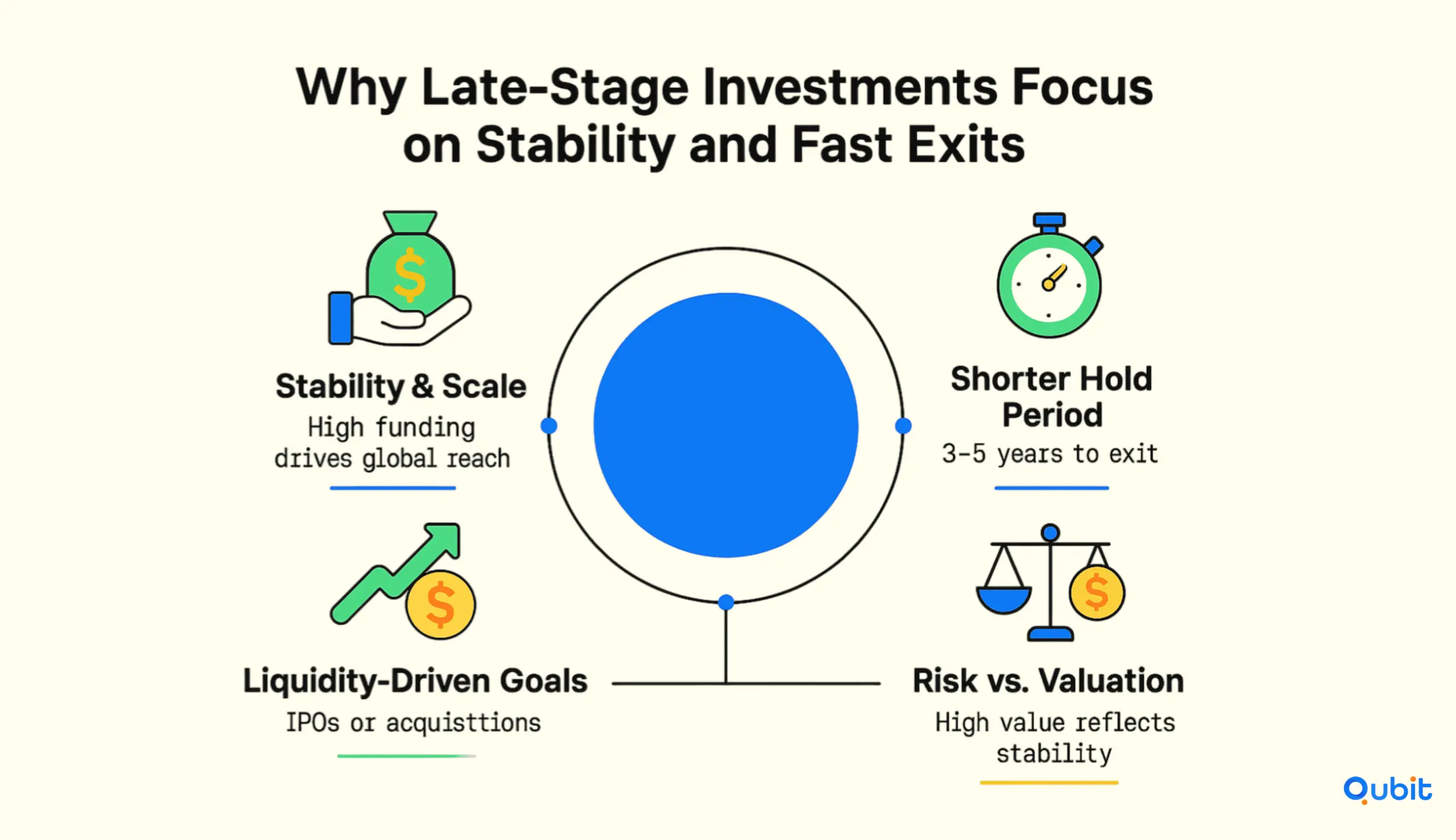Early-stage startups often focus on building foundational financial infrastructure, such as identifying the best banks for startups to manage their initial capital. In contrast, late-stage startups prioritize scaling operations and attracting larger investments to fuel growth.
This blog explores the nuances of funding across these stages, offering insights into how startups can align their financial strategies with their growth objectives. For a broader overview of raising funds at multiple stages you can learn about different startup fundraising strategies.
How Early-Stage Investments Can Drive Growth and Balance Risk
Early-stage investments play a pivotal role in shaping the trajectory of startups, particularly during their seed and Series A funding rounds. At this stage, companies focus on product development, market entry, and refining their go-to-market strategies.
Specialized financial support, such as convertible notes and preferred equity, helps startups secure the resources they need to scale effectively, making banks that fund startups essential partners in this journey.
Seed Stage: Building the Foundation
Seed-stage companies often prioritize creating a minimum viable product (MVP) and testing its market fit. Convertible notes, a popular funding mechanism, allow startups to raise capital without immediately determining valuation. This flexibility is crucial for early-stage businesses navigating uncertain markets. For example, Dropbox’s MVP validation demonstrated how lean testing can refine product offerings before scaling.
Refining Strategies in Series A
As startups progress to Series A funding, they shift focus to refining sales channels and positioning themselves for scalability. Preferred equity becomes a key tool for optimizing investor terms, enabling founders to retain control while attracting significant capital. This structured approach differentiates Series A funding from seed capital, as companies move beyond initial development to establish sustainable growth models.
Balancing Risk and Reward
Early-stage investments are inherently high-risk but offer the potential for exponential returns. Case studies like Airbnb and Uber illustrate how early bets on innovative ideas can yield extraordinary outcomes. However, these investments often require a longer holding period, typically ranging from 7 to 10+ years, underscoring the importance of patience and strategic foresight.
For startups seeking to master funding strategies, a review of how to raise capital for startup offers foundational insights that complement this analysis.
Why Late-Stage Investments Focus on Stability and Fast Exits

Late-stage funding is a pivotal phase for startups that have already established themselves in the market. At this point, companies typically boast stable revenue streams and a proven business model, making them attractive to investors seeking lower-risk opportunities. These investments often emphasize stability while aiming for faster returns through liquidity events such as IPOs or acquisitions.
One defining characteristic of late-stage investments is the scale of capital injection. With check sizes often exceeding $10 million, as seen in the "Late Check" statistic, investors provide substantial funding to fuel aggressive growth strategies. For instance, the case of TechFusion Expansion highlights how late-stage funding enabled the company to scale globally, solidifying its market dominance.
Another key focus is the shorter holding period. Investors in this stage often aim for exits within three to five years, as demonstrated by the "Late Exit" statistic. This accelerated timeline aligns with the maturity of these startups, which are already positioned for liquidity events. Higher valuations also play a significant role, reflecting the reduced risk and established market presence of these companies.
For startups preparing for late-stage funding, advanced financial solutions like bank accounts for business startups become essential. These accounts help manage larger capital flows efficiently, ensuring the company is equipped to handle the complexities of scaling operations and preparing for an exit.
Comparing Investment Stages: From Seed to Scale
The journey from seed funding to scaling a business is marked by distinct phases, each with unique financial needs and investor dynamics. Understanding these stages is essential for evaluating risk and return profiles, as well as crafting effective funding strategies.
Early-Stage Funding: Seed and Series A
Early-stage funding focuses on helping startups establish their foundation. Seed funding, often the first external capital raised, supports product development, market research, and initial operations. Investors at this stage, such as angel investors or venture capitalists, prioritize potential over proven performance.
Series A funding builds on the seed stage, enabling startups to refine their business model and expand their customer base. Valuation methods here often rely on projections and market potential rather than historical data. Investors seek high-growth opportunities, balancing risk with the promise of significant returns.
Late-Stage Funding: Series B and Beyond
As startups mature, late-stage funding becomes critical for scaling operations and achieving profitability. Series B funding typically supports market expansion, while Series C and beyond focus on optimizing processes and preparing for potential IPOs or acquisitions.
Valuation methods evolve in late-stage funding, relying more on tangible metrics like revenue, profitability, and market share. Investors, including private equity firms and institutional funds, prioritize stability and scalability, often adopting portfolio strategies that minimize risk while maximizing returns.
Key Differences in Investor Preferences
Investor priorities shift significantly between early and late stages. Early-stage investors are drawn to innovation and disruptive potential, often accepting higher risks for the chance of exponential growth. Late-stage investors, on the other hand, focus on established companies with proven track records, favoring lower-risk investments with predictable outcomes.
An examination of ways to secure capital for startup presents stage-specific funding methods that integrate seamlessly with the overall discussion of financing evolutions.
Economic Impacts Across the Startup Life Cycle
Funding stages also influence broader economic trends. Early-stage investments drive innovation and job creation, fostering entrepreneurial ecosystems. Late-stage funding contributes to economic stability by supporting mature businesses that generate consistent revenue and employment.
Financial Solutions for Scaling Businesses
For startups transitioning from seed to scale, choosing the best business bank accounts for startups is crucial. These accounts provide tailored financial tools to manage growth effectively, ensuring smooth operations during critical scaling phases. Additionally, exploring an online bank for startups can offer flexibility and convenience, aligning with the fast-paced nature of modern business.
Understanding the progression from early-stage to late-stage funding equips entrepreneurs and investors with the insights needed to navigate the complexities of the startup life cycle. By recognizing the distinct characteristics of each phase, stakeholders can make informed decisions that drive sustainable growth.
Tackle Risks and Overcome Challenges in Startup Funding
Startup investments often come with high stakes, characterized by volatility, cash flow challenges, and potential illiquidity. Early-stage ventures, while offering exponential growth opportunities, frequently operate on unproven business models, making them inherently risky. For instance, 38% of startups fail due to cash shortages, highlighting the critical need for prudent financial planning and risk management.
Diversification is a key strategy to mitigate these risks. By spreading investments across various sectors, investors can reduce exposure to individual startup failures. Emerging industries, such as climate tech, present both significant risks and massive upside potential, making them attractive yet unpredictable options for diversification.
Effective risk management also involves understanding the nuances of startup funding. A discussion on fundraising challenges and solutions presents an objective look at common obstacles within the fundraising process, aligning with the broader narrative of startup financing.
Ultimately, balancing risk and reward requires a comprehensive approach that combines diversification, sector analysis, and financial foresight. By adopting these strategies, investors can navigate the complexities of startup funding with greater confidence.
Create a Balanced Portfolio for Early-Stage Investments
Building a portfolio of early-stage investments requires a thoughtful approach to balance risk and reward. By focusing on diversification, investors can position themselves to uncover high-growth opportunities while minimizing exposure to potential losses.
Early-stage portfolios typically consist of numerous smaller investments, each representing a calculated bet on innovative startups. This strategy increases the likelihood of identifying a "unicorn"—a startup with exponential growth potential—while ensuring that setbacks from individual ventures do not significantly impact overall returns.
Diversification is key to mitigating risks in this space. Spreading investments across industries, geographies, and business models allows investors to maximize exposure to groundbreaking ideas while reducing reliance on any single company’s success. For those exploring structured investments, an analysis of startup funding options highlights a range of financing methods, from equity to debt, that directly relate to the contextual themes of capital acquisition.
Ultimately, a balanced portfolio for early-stage investments is about creating a dynamic mix of opportunities. By making many smaller bets, investors can capture the upside of innovation while maintaining a safety net against the inherent volatility of startups.
Maximize Returns with Focused Late-Stage Investment Portfolios
Late-stage investment portfolios prioritize precision and impact. Unlike early-stage strategies that spread capital across numerous ventures, these portfolios concentrate on fewer, larger investments in companies with proven track records. By focusing on established businesses, investors can minimize risk while targeting ventures with clear paths to liquidity.
This approach is designed to optimize returns by emphasizing stability and high-value opportunities. Late-stage investments typically involve companies that have already demonstrated market viability, scalability, and consistent revenue streams. With these factors in place, investors can make informed decisions about where to allocate resources for maximum growth potential.
Concentrated portfolios also allow for deeper engagement with individual companies. This enables investors to provide strategic support, ensuring that the businesses are well-positioned for successful exits, whether through acquisitions, mergers, or public offerings.
Conclusion
Carefully evaluating the strategies discussed, founders can craft a compelling pitch that highlights their vision while addressing potential risks. Strategic planning, coupled with a clear narrative, ensures investors see the value and scalability of your business.
If you're ready to act on these insights and need expert guidance, we at Qubit Capital are here to assist. Whether you're seeking seed capital, Series A funding, or debt financing, our Fundraising Assistance service is designed to help you achieve your goals. Let's get started today!
Key Takeaways
• Early-stage investments offer high-risk, high-reward opportunities with longer holding periods.
• Late-stage investments bring stability, larger check sizes, and quicker exit options.
• Diversifying early-stage portfolios helps mitigate risk and uncover potential unicorns.
• Grasping investor decision drivers and market trends is vital at every stage.
• Combining funding approaches lets founders and investors navigate the startup lifecycle effectively.
Frequently asked Questions
What is the difference between early stage and growth stage startups?
Early-stage startups are typically in the process of proving their market potential and building foundational product offerings, while growth-stage startups have established revenue streams, infrastructures, and a clearer path to scalability.


 Back
Back



